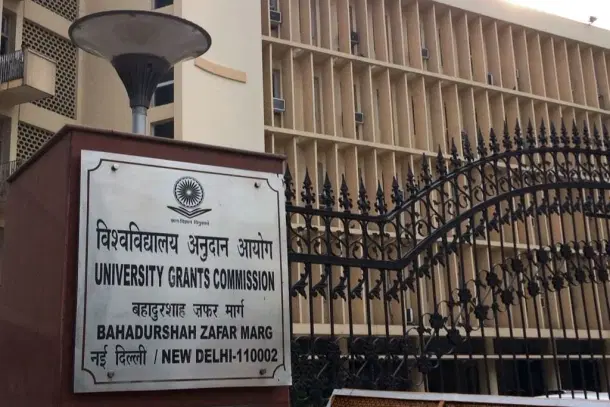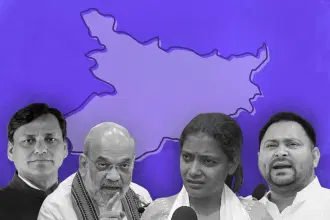Commentary
Why UGC's Push For Indian Knowledge Is NOT A "Threat To Education"
V Ramanathan
Sep 02, 2025, 10:44 AM | Updated 10:44 AM IST
Save & read from anywhere!
Bookmark stories for easy access on any device or the Swarajya app.


It is not very long in the past that our country witnessed MoSE, a much-hyped exhibition on the ‘Method of Science’, conceived by none other than the venerable Padma Bhushan Dr P. M. Bhargava. The exhibition had a section titled ‘21 landmarks in the history of the method of science and its applications’ with a clever caveat: “what is presented here is not a display of landmarks in the history of science but landmarks in the history of the method of science.”
It featured personalities like Karl Marx, Friedrich Engels, and Vladimir Ilyich Ulyanov, better known as Lenin. One wonders what these personalities discovered or invented in the field of science. But who cares for details when ideology is blatantly peddled using the taxpayer’s money?
Shameless displays of such monstrosities in the name of science, or even method-of-science exhibitions, dared not invite any comment then. Alas, we live in different times now. Those were the golden days of naked propaganda of a particular ideology, perhaps much in alignment with a section of current opinion makers and commentators.
Articles like “Ten Reasons Why UGC’s Push for ‘Indian Knowledge’ Is a Threat to Education”, and the ilk, read like a manifesto of woke anxiety, a frenetic dance between a deep-seated fear of tradition and a colonial-era obsession with appearing enlightened.
These authors, clearly educated in a system that worships Eurocentric and postcolonial orthodoxies, exhibit the familiar habit of transforming Indian Knowledge Systems (IKS) into a faintly terrifying “other,” best kept at arm's length as a threat to the sacred altar of Western modernity.
From the very first line of The Wire piece, “This is not just adding new chapters to a textbook; it is a plan to change the meaning of education in India,” one is transported into a world where the mere inclusion of Indian heritage morphs into a sinister project to rewrite reality.
The article’s insistence on binary oppositions such as “science versus myth, secularism versus tradition, critical thinking versus reverence” is a guaranteed crowd-pleaser in the woke theatre of academic critique. It is a shorthand that says, “We must protect the sacred temple of rationality from these quaint, obsolete traditions.”
The version of education this author champions is a museum of ossified rationalism that “teaches how to think,” but only as long as those thoughts do not stray into uncomfortable territories such as indigenous knowledge, plural epistemologies, or—heaven forbid—the spice of cultural pride.
The claim that IKS “teaches what to think, not how to think” sounds suspiciously like someone mistaking reverence for tradition to be intellectual dictatorship. The current NCERT and UGC syllabi, however, explicitly invite students to debate. But why bother with nuance when you can script your outrage with sweeping declarations?
As for mixing “past and present absurdly” by invoking Ram Rajya as a lesson in Corporate Social Responsibility (CSR), one might ask: why not? If we can push ancient texts into boardrooms and MBA curricula around the world, surely India’s educators deserve the prerogative to explore their own heritage.
Yet the author treats such interdisciplinary synthesis as a Frankenstein-esque abomination, ignorant of international academic innovations where China, Japan, and Finland flaunt just such integrative pedagogies. But nuance is the enemy of woke certitude.
The article’s loudest guffaws come in denouncing the blurring of “science, art, and myth” as evidence of impending educational collapse. To brand indigenous knowledge systems comprising centuries-old contributions in mathematics, medicine, and ecology as myth is not scholarship; it is colonial nostalgia donning the cape of woke wisdom.
Scientific American, one might remind, applauds the fusion of “indigenous, experiential knowledge with contemporary methodologies” as foundational to global innovation. But facts be damned, as it is easier to accuse Indian thought of being “myth” than to grapple with Mādhava’s precocious calculus or the epistemological rigour of Indian logicians predating Descartes.
In a spectacular display of selective outrage, the article laments that the curriculum “erases the knowledge of the oppressed” due to its supposed focus on a singular “Indian Knowledge System”. The tragic blind spot here is that recent curricular reforms deliberately include plural narratives, precisely to counteract the kind of erasure the author hypocritically laments.
But inclusion is inconvenient when one prefers the reductive drama of victimhood and exclusion.
The recurring howl about the curriculum “promoting loyalty, not criticism” and fostering “a sense of national pride” sounds inked by a scholar terrified of patriotic young minds. Evidently, cultivating pride in one’s own civilisation is less acceptable than producing graduates skilled only to “apply formulas but not invent them,” a workforce destined for “routine technical jobs”.
Such a patronising stance infantilises students and dismisses India’s attempts at educational self-assertion on the world stage. It is important to remind readers how Rutherford retorted to C. V. Raman by saying, “We do not grow bookworms here, rather we grow men who can govern empire.”
One might also note the author’s dismay at the presence of figures like V. D. Savarkar in the curriculum, who famously argued for Hindu nationalism, as part of a “political agenda”. Yet presenting a range of ideological perspectives is the very essence of liberal education, something seemingly lost on a writer ensconced in a woke monoculture that shuns any deviation from its favoured narratives.
Finally, his tone of impending doom, warning that without his preferred curriculum students will be “worse off after four years” and that India risks “falling behind,” is speculative fear-mongering detached from ongoing academic reforms and outcomes.
The author misses that education today must blend adaptability, interdisciplinarity, and cultural literacy to prepare students for a complex future, not fossilise them in rigid, outdated traditions.
Ultimately, the article’s tone exemplifies an entrenched bias toward traditionalist rigidity, a lack of engagement with contemporary educational scholarship, and a dismissive stance on any reform that challenges the status quo.
Far from an objective call for rigour, it reads as a defensive reaction to necessary evolution in pedagogy, curriculum design, and the relationship between knowledge and culture. It is a typical neurotic hand-wringing session, a classic case of “defensive projection,” born of ignorance and a profound unease with the unfamiliar.
It betrays an authorial mind shackled to colonial textbooks and an anxiety-ridden education system that fails to embrace plurality, creativity, and the full spectrum of Indian and global knowledge.
Until such commentators shed their cold war anxieties and their woke-scripted certainties, their shrill denunciations will remain a hindrance to genuine intellectual progress and a thriving educational ecosystem.
Let India’s education system dare to blend tradition with modernity, pride with critique, and home-grown knowledge with global scholarship. That is the true path forward, not the static, fearful nostalgia of those who mistake cultural respect for intellectual submission.
It is worth recollecting the words of Sri Bhyrappa who said:
“We cannot truly comprehend our own selves or the history of our nation or, indeed, the history of the entire world, unless we unshackle ourselves from the bonds of false knowledge, desire and action, and elevate the intellect to a state of detached observation.”
Dr V Ramanathan is an Associate Professor, Department of Chemistry, at the IIT-BHU (Varanasi).




